|
|
Welcome to my travel log! You will find here a lot more than in the travel reports, stripped from political correctness. Enjoy! 
Mar 01, 2013 08:00 PM Marrakech - second day, a good day
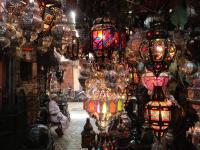 Today, has been a good day. I had two objectives. The first one involved the rose-red ramparts, green palmtrees and snowy peaks of the High Atlas - all in one frame. And I achieved it. A photo like this can be taken near the southern end of the medina, opposite the Golden Tulip hotel. I was there just before noon, which was not the most optimal time. I think one should head there either soon after sunrise or before just before sunset. Visibility today was not great, either but some of the pictures came out okay.
Today, has been a good day. I had two objectives. The first one involved the rose-red ramparts, green palmtrees and snowy peaks of the High Atlas - all in one frame. And I achieved it. A photo like this can be taken near the southern end of the medina, opposite the Golden Tulip hotel. I was there just before noon, which was not the most optimal time. I think one should head there either soon after sunrise or before just before sunset. Visibility today was not great, either but some of the pictures came out okay.
The other objective was to navigate the maze of the medina to find the souk, at which Harry Potter would buy various remedies and lanterns. The best way to navigate the medina is just simply dive into it and getting lost. I had a vague idea where I was most of the time, but I did manage to find a few dead ends. Some of the lanterns were exquisite and I wish I had brought a larger bag, as I might have bought a couple. They looked fantastic as a bunch, though. Well, when I get a bigger place one day, I might just get a few for the hallway or the bedroom.
Back in 1996, the merchants were a lot more pushy than today. It was actually nice to chat to them and they did not insist that much for a purchase. Plus, a good trick was to simply say that I was not allowed to make any purchases without my wife. And if I did she would kill me. I was happy to take a few pictures to show her what the different and lovely merchandise there was for her to decide upon. They never argued about that.
For sunset, I went back to Djamaa el Fna. I sat at the Le Grand Balcon du Cafe Glacier, had late lunch and drank coke (for the lost energy hiking for miles and miles, I never used a taxi once) and mint tea. It was a good spot to see the panoramic view of this magical square, spotting the king cobra charmers, evil monkey masters, somewhat bored dried fruit, nuts and dates merchants, joyful juice pressers, handsome acrobats, dubious musicians, greedy hat spinners, and... tourists. As the day was coming to an end, the food stalls were being installed and almost instantly smoke from the wood burnt grills began billowing above the square.
Then, as the sun set, it was time to browse the food stalls, and some of the lantern shops. I resisted many touts of the food stalls again. I wanted to find a relatively busy one and one that was managed by friendly, rather than pushy, touts. And I found one. It was number 97, Chez Hisham. There were three friendly touts working there. One of them had an infectious grin. His name was Sufien (not sure about the spelling). He spoke French, English, Spanish, Arabic (a standard combination really), and a bit of Italian. It was him that told me a secret about the belly dancers at the square. Now, the secret was that these dancers were not real women. They were not real men, either. In fact, they were gay men. Since they had their faces covered with nikrams, one could not see their Adam's apples or any facial hair they might have sported underneath.
I had some lamb kefta at the food stall and loads and loads of free mint tea. And then, it was time to relax. Before the night out at the town.
|
Feb 28, 2013 08:00 PM Marrakech - it's been a while
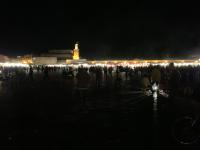 Last time I was in Marrakech, or in fact, Morocco, was in September 1996. Back then, I had my own mode of transport and was staying at camping sites under a small tent. It took three days to arrive in Morocco from Warsaw, Poland. This time, it is different. I have flown directly from Gatwick. It took just over 3 hours. And I am staying at the plush Le Meridien N'fils Marrakech hotel, at one of their executive suites, which is larger than my entire flat in London. And the king size bed in the bedroom is about three times as large as my tent from back in 1996.
Last time I was in Marrakech, or in fact, Morocco, was in September 1996. Back then, I had my own mode of transport and was staying at camping sites under a small tent. It took three days to arrive in Morocco from Warsaw, Poland. This time, it is different. I have flown directly from Gatwick. It took just over 3 hours. And I am staying at the plush Le Meridien N'fils Marrakech hotel, at one of their executive suites, which is larger than my entire flat in London. And the king size bed in the bedroom is about three times as large as my tent from back in 1996.
I relaxed for an hour after landing, mainly to charge my phone battery. And then I walked to the infamous Djamaa el Fna Square in the medina. It did not change a bit! The countless food stalls were still there, so were the musicians, kitsch sellers, juice pressers, dried fruit merchants, kids running chaotically everywhere and loads and loads of touts of all kind. It was good! The smoke billowing from the grills, the music from the drums, the lights flickering through intricate and colourful iron-and-glass lamps and the minarets of the medina lit up and looming in the distance, and all the crowds made the square unique and legendary.
I wandered around the square between the food stalls dodging the Ahmeds, Idrisses, Mustafas, Mohammeds, Taufiks, Bilals, Musas, Issas... occasionally peeking into the shops, and tea houses, taking pictures of the juice pressers and dried fruits merchants. And the entire square, trying to capture the ambiance and the animation of this very special spot. One of the Ahmeds took a couple of minutes advertising his food stall (number 118), showing all sorts of meals he could sell me tomorrow. It did not look any different from any other food stall, including the two immediately adjacent. I asked him if he had tea, and of course he had. The trick is that one can order almost anything extra, what's not on the menu, and it will be organised. A kid will be summoned to fetch whatever one wished to have. So, also in this case, a glass of mint and very sweet tea was promptly delivered. I sipped the tea and soaked the atmosphere. It was amazing.
I honestly do not remember the prices from 1996, but I am under an impression that they might not have changed that much in the last 17 years. Today, a glass of fresh orange juice is 4 dirhams, and I have a strange feeling that it was 4 dirhams back in 1996. Or was it 1 dirham? Hmm... Anyway, even today it is a rather good value for money, since 12 dirhams buy £1 Sterling. Three glasses of fresh orange juice for a pound is a jolly good deal!
|
Dec 29, 2012 08:00 PM Caribbean Extravaganza - in Santo Domingo
I had the honour to land at the old Santo Domingo airport, La Isabela International Airport. It still serves some smaller air traffic, mainly from around the Hispaniola Island and nearby. It had three cash dispensers, a bureau de change and taxis waiting. A ride to town made a dent of DOP1500 (the drivers would quote this in USD - $35). The traffic was terrible. The driver explained that because of the end of the year, people are all up and about the city to deal with their ‘must-do-by-the-end-of-the-year’ business.
Hilton upgraded me to the executive floor with an easier access to the Executive Lounge, where I had breakfast. I took a second shower, changed and obtained a map from the concierge. I hiked along the Malecon waterfront all the way to the Colonial District. A few venues were closed on Monday, including the fort, but otherwise it was a nice place to see. It was not crowded. At least Plaza de Espana, where the Alcazar stood - complemented by a large artificial, orange Christmas tree. I circumnavigated the old town and sat down at the Plaza at one of the restaurants for late lunch. Out of the Pura Tasca, Harry’s, Rita’s Cafe, Pat’e Palo, Mamajuana and Angelo Ristorante, I picked the last one. It was specialising in Italian dishes and their pizza ranged from DOP350 for a Margarita to DOP1,250 for a lobster pizza. Plaza de Espana was probably my favourite spot in Santo Domingo, although Parque Colon with the adjacent Cathedral (the oldest, or even first cathedral in the Americas) was also nicely animated. Much more touristy than Plaza de Espana. Singers entertained ostentatiously all who sat at pavement tables of the only cafe at the piazza. I do not mind listening to the music and hear people sing, but those guys at Parque Colon could not, and should not, sing! It was painful.
I then walked the entire length of the pedestrianised Calle el Conde full of souvenir shops, boutiques, shops and eateries, as well as beauty saloons where one could get pampered up a little with a massage included. Special massage, that is. I was offered all sorts of services, although it was only along the waterfront where every single guy, aged from 16 to 76, seemed to be a pimp. One of them claimed to be from Haiti. He was better looking than most guys I spotted in Port-au-Prince and Petionville the day before. Tall, slim, with a complete set of pearl white teeth. I was impressed with his English, actually. He also offered me all sorts of services and then asked for some money so he could buy some food. I let him clean, or rather attempt to clean my white adidas trainers and paid him for that. Erm… overpaid him for that! I know that, because he gave me a hug grinning uncontrollably. He did not look poor or dirty. He was neatly dressed and had a very clean pair of sneakers on.
The waterfront, or Avenida George Washington - Paseo Presidente Billini, had a few places to go out for a meal or drink. It even had an open-air gym with a good selection of machines, like cross country skiing, stepping, pulling strings, bars etc. So, one could exercise there amongst gracious palm trees watching the sea smashing on the shore - sometimes providing a slight, refreshing spray.
I liked the D’Louis Parrillada, closer to the Zona Colonial. It had a good number of tables overlooking the sea and a relatively nice bar. The trick was that it was opposite a number of gentlemen’s clubs, so it attracted a clientele with mixed moral values, shall we say. Although I do believe that most diners were completely innocent.
The next door, split level open-air Parrillada Malecon 7, also had tables by the sea and served traditional and creole dishes at reasonable prices. Their large 0.6l bottle of Presidente lager was DOP175. It was less busy that D’Louis. Maybe due to a small swarm of pimps that sat almost right at the entrance.
Santo Domingo had a particular phenomenon. Haitian immigrants were pushing supermarket trolleys down the streets fully loaded with snacks, mainly crisps. As the locals were hanging around on the waterfront’s endless benches and parks, often sipping rum and beer, the snack trolleys did come handy. Occasionally, the trolley drivers would converge at a section of the avenue and exchange opinions on a number of things. They spoke French Creole and almost all matters that they discussed were dead serious.
On the waterfront near the Hilton, the city was putting up a large stage, blocking the pavement completely and one lane of the road. It was for the New Year’s Eve preparation. I am quite sure that the size of the speakers was selected deliberately to blow ladies’ garments off their bodies. They were testing the power of those speakers until midnight! I actually did not see any clothes being ripped off of anyone, but the window pane in my hotel room shook and shook. And I was on 20th floor!
So far, I found the Dominican People friendly and approachable. One has to be careful not to maintain the eye contact for too long. That meant that you wanted something. And by something, I mean sex. And it did not matter if it was a girl or a boy. They were prepared to oblige whatever your preference was. From the other hand, that was very convenient. More than in Paris or even Rome. Considering that the people rather good looking and well proportioned, Dominican Republic could actually be a dream destination. Just joking!
|
Nov 17, 2012 08:00 PM South Pacific - Milford Sound, Queenstown - and flights back home
 An early call to the airport and it was confirmed. The flight and cruise to Milford Sound was going to happen! A car picked me up at 07:30am for the 08:00am flight. The aircraft could carry only six passengers and two pilots, or seven passengers and a single pilot. There were six of us going. The pilot invited me to co-pilot with him, which was great as the views from that seat were breathtaking. The landscape of the Southern Alps and Fjordland of New Zealand was awesome. And that little light aircraft kept passing so very near the snow-capped peaks! The thrill was immense.
An early call to the airport and it was confirmed. The flight and cruise to Milford Sound was going to happen! A car picked me up at 07:30am for the 08:00am flight. The aircraft could carry only six passengers and two pilots, or seven passengers and a single pilot. There were six of us going. The pilot invited me to co-pilot with him, which was great as the views from that seat were breathtaking. The landscape of the Southern Alps and Fjordland of New Zealand was awesome. And that little light aircraft kept passing so very near the snow-capped peaks! The thrill was immense.
The flight took 45 minutes as the aircraft cruised at 125 knots on average. A quick pick up at the airport and by 08:50am, I was standing at the boat landing at Milford Sound. The boat left at 09:00am and slowly moved along the fjord all the way to the Tasman Sea, passing by a number of waterfalls, a small seal colony and a group of the rare crested penguins. Apparently, certain sailings see also dolphins. Not this time. The cruise lasted 2 hours, and by noon, I was back at the Queenstown International Airport. Ready to check in to go home.
I had 1h15' to make my connection in Sydney. If there are no lines at the transfer security check, then one needs probably just 10 minutes to cross over. And if the flights are within the same airline alliance then maybe even less. I landed 10 minutes late and taxied for further 10 minutes, leaving me about 15 minutes before boarding of the London flight commenced. I had to run across the entire terminal, but I did make it on time. The problem was that my bag did not. Already at the gate, I was told that my bag would not travel with me. I was not happy at all, but the lady at the gate kept re-assuring me that my bag should make it on the next flight, yet it might take even 24 hours after landing in London before I could see my Hartmann trolley again.
|
Nov 16, 2012 08:00 PM South Pacific - Rarotonga (CK) & IDLG & Queenstown
 And so, my flight from Rarotonga to Auckland on Virgin Australia was delayed by 4 hours! This meant that I was not going to make the Queenstown connection at Auckland at 07:05am. I would have not landed until 08:05 from Rarotonga yet! And with the next possible connection, allowing 1h30' from the international to the domestic terminals, was leaving Auckland at 10:05am, scheduled to arrive in Queenstown at 11:55am - too late for my noon flight to Milford Sound! So, I was gutted. Fortunately, I had a flexible ticket booked from Auckland to Queenstown with Air New Zealand. Less stress and expense than otherwise it would have been; all the deal with buying a fresh ticket, then claiming back from the insurance company, who always try to pay nothing making all claims so difficult.
And so, my flight from Rarotonga to Auckland on Virgin Australia was delayed by 4 hours! This meant that I was not going to make the Queenstown connection at Auckland at 07:05am. I would have not landed until 08:05 from Rarotonga yet! And with the next possible connection, allowing 1h30' from the international to the domestic terminals, was leaving Auckland at 10:05am, scheduled to arrive in Queenstown at 11:55am - too late for my noon flight to Milford Sound! So, I was gutted. Fortunately, I had a flexible ticket booked from Auckland to Queenstown with Air New Zealand. Less stress and expense than otherwise it would have been; all the deal with buying a fresh ticket, then claiming back from the insurance company, who always try to pay nothing making all claims so difficult.
I rushed through arrivals. I switched on my stopwatch to see how long it was going to take to: pass through international arrivals, clear immigration, complete customs bag screening including x-ray, travel on the very slow 'every 15 minutes' shuttle bus to the domestic terminal, re-book my flight and check-in to Queenstown. There was a massive line to the immigration desk, which looked like Korean and Japanese invasion, and then the customs clearance line was terrible, too - but one of the officers directed me to the fast lane. Since I carried shells and wood, I had to x-ray my bag, which meant another line... Fortunately, I was not stopped and could exit into New Zealand. The shuttle bus was 5 minutes away, however the driver was driving 5km/h! I reached the domestic terminal half an hour before the flight I hoped to take. I thought it was too late. But it was not. A lady at the Special Assistance desk (all other desks were impossibly busy) re-booked me, checked my bag in, her colleague who was talking to her before I approached, dropped my bag off and I was handed my boarding pass to the 10:05am flight to Queenstown. I checked the stopwatch. It was showing: 1h00'27". Not bad, compared to the recommended 'allow 3hrs to transfer between international and domestic flights in Auckland'.
The plane landed in Queenstown at 12:05pm. After ejecting myself from the aircraft, I proceeded to the Glenorchy Airlines to see about my Milford Sound trip. It was cancelled due to bad weather and people were being re-booked for the next day. I said that this would only work for me if it was 8am departure returning to the city in time for my departure to Sydney at 13:55... The lady said that would try.
So, I took a taxi to my Hilton hotel and had 2 hour long lunch.
Then, I relaxed and went to see Queenstown. It was raining. But I loved the town. It was well organised, clean, safe, friendly and the surroundings were fantastically stunning.
|
Nov 15, 2012 08:00 PM South Pacific - Rarotonga (CK) & International Date Line Bonus (IDLB)
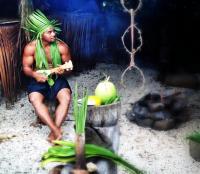 I had no 16th November 2012 in my calendar, due to the crossing of the International Date Line again, but I had two 15th November 2012 days, as I crossed the line in the opposite direction first.
I had no 16th November 2012 in my calendar, due to the crossing of the International Date Line again, but I had two 15th November 2012 days, as I crossed the line in the opposite direction first.
The day on Rarotonga was easy. A visit to Avarua, the capital, and a round the island trip. It takes about 45 minutes to circumvent the island. And I have to say that, compared to all of the islands that I visited on this holiday before, Rarotonga had little to impress. The beaches were small and dull. The lagoon colours looked more grey than turquoise, and there were no interesting village to speak of. The mountainous interior with at least two interesting peaks, might win a few points, but that would be no different to what one could do on Tahiti, Mo'orea, Bora-Bora, Viti Levu or 'Upolu. And many islands in between.
The only highlight of my stay on Rarotonga was the visit to the Te Vara Nui cultural village. I normally do not do 'artificial' villages, but there was very little to do on the island otherwise. And it was great. It was educational and great fun. Mostly due to the personnel, who explained the Rarotongan life but also put a lot of positive energy to it, superb humour and stunning looking people. There was a feast afterwards and some theatre, which depicted a Rarotongan legend.
|
Nov 14, 2012 08:00 PM South Pacific - 'Upolu (WS) to Rarotonga (CK)
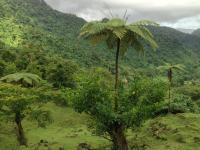 Now, sadly, this part of the trip was ridiculous. It required me to travel almost 4 hours south from Apia on the 'Upolu island in Samoa to Auckland only to wait 3 hours at the airport for a connecting 4 hours flight north to Rarotonga. Whilst 'Upolu and Rarotonga are just about 1.5 hours of flight apart! However, this part of the world seems less populated, more culturally and economically disconnected to justify more direct flight connections between the islands.
Now, sadly, this part of the trip was ridiculous. It required me to travel almost 4 hours south from Apia on the 'Upolu island in Samoa to Auckland only to wait 3 hours at the airport for a connecting 4 hours flight north to Rarotonga. Whilst 'Upolu and Rarotonga are just about 1.5 hours of flight apart! However, this part of the world seems less populated, more culturally and economically disconnected to justify more direct flight connections between the islands.
In the morning, since the airport was exactly on the other side of the island, I could see the interior of the island, ocean trenches, beaches, villages, and the capital - Apia, before embarking on this ridiculous leg of the holiday. And the island looked great! The jungle inside of it resembled film sets from Jurassic Park!
I learnt that, as in Vanuatu, Samoa had their chiefs (and in fact four royal families above them) in each family and village and that, although there were state laws and regulations, each village had their own as well. The village laws could not contradict the state laws, yet apparently, there was still a lot room to manoeuvre for the chiefs and the Village Councils to impose their ruling. The police step in only if a matter is to heavy for the chief or the Council to handle.
For example, if someone steals a pig (a small thieving matter), the council is likely to rule that the person would have to give up 5 of their pigs and pay a fine. The money would go to the village budget. The pigs would be killed and divided between the family chiefs and eaten. But if the thief could not provide pigs and the fine, they would be banished from the village. The banishment is the worst shame in Samoan culture.
My flight to Auckland was on time. The international to international transfer was completely painless. And if one had just 30 minutes between the flights, the connection should be perfectly doable.
My Rarotonga flight had a technical fault (they had to change a tire...), so I departed about 20 minutes late. On Rarotonga, no-one was there to collect me, although almost all hotels had representatives meeting their guest and welcoming them with garlands of flowers. I booked a garden suite at the Manuia Beach Resort, but I guess I was not welcomed that much. One has to bear in mind that after midnight, there are no taxis on the island, and that includes the airport. I landed at about 1:00am. So, I was stranded. Me, another British lad (although much younger than me, and staying at the International Backpackers), and a group of three staying somewhere else. An airport employee, named Martha, was kind enough to wake up one of the taxi companies and organised transport two taxi for us. One for the group of three, and the other for me and Rich. Rich was concerned that that the taxi was going to charge NZD4 per kilometre per person, rather than per vehicle, which would meant that we might not be able to share the fare. I told him no to worry about it. Eventually, the taxi cost cost NZD40 in total, which was NZD4 per kilometre per vehicle, so we were able to share the cost, but instead, I just gave Rich NZD50 (as I disembarked first) for him to have enough.
|
Nov 13, 2012 08:00 PM South Pacific - 'Upolu (WS)
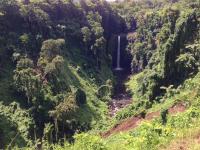 I thought I could have a lazy morning, after arriving late at night, but no. There were two ‘breakfast ready’ knocks at my door at 8:30am and at 9:00am. So, I rolled out of the bed earlier than I planned. I guess this was good for me. I always want to get up early and make most of a day, yet not being a morning person, this does not always work out well. But when I do, the day is great.
I thought I could have a lazy morning, after arriving late at night, but no. There were two ‘breakfast ready’ knocks at my door at 8:30am and at 9:00am. So, I rolled out of the bed earlier than I planned. I guess this was good for me. I always want to get up early and make most of a day, yet not being a morning person, this does not always work out well. But when I do, the day is great.
After breakfast, it was time to relax on my private terrace overlooking ‘Upolu’s loveliest beach - the Lalomanu beach. It was badly damaged during 2009 tsunami, so I thought it was a good idea to stay there and support the local community. 42 people from Lalomanu died in that tsunami and many families subsequently moved up the mountain, and re-built their homes there. Apparently, the first wave that hit did not cause that much damage. It however bounce off the giant wall of the mountain only about 50 yards from the shore, and met with the second wave. They collided right in the middle of the main road and with a combined force, which distributed itself if many directions, demolished people homes and caused death. The Lalomanians had no warning whatsoever. I heard reports that people saw the ocean withdrawing dramatically exposing the coral reef. And the giant wave followed soon after. People did not have enough time to climb the mountain.
And although many houses survived, including the school, a large proportion of people decided to move up the mountain. They took the steel work and their roofs, left the shells of the houses, and rebuilt their homes a couple of miles up the hills.
Now, although Lalomanu beach receives reports of the loveliest beach on ‘Upolu, i would argue that there was another, which could easily contest that title. It was the Faofao beach near Salepanga village. It also had white sand and fale to rest your back. But in addition, it had a few leaning palm trees, that made the spot picture perfect. The Nuutele Island was still visible from Faofao, and Lalomanu claimed the proximity of this island made it so nice.
In the early afternoon, it was time to explore the southern tip of ‘Upolu. I walked all the way from Lalomanu to Salepanga. It was about 9km and it was hot! In Salepanga I just took a taxi and I went to see the Sopoaga waterfall. I am not into waterfalls this much, but this one was rather nice. It was a single fall, dropping amongst impossibly lush foliage. The viewpoint, right by the main road, was perfect. The local botanic garden that was there charged 5 tala for the privilege to see the waterfall. A local person would normally be there to collect the fee, but otherwise there was an honesty box, where people could deposit the money.
|
Nov 12, 2012 08:00 PM South Pacific - Tongatapu (TO) - Viti Levu (FJ) - 'Upolu (WS)
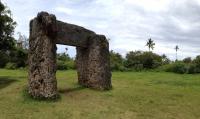 The 13th day of November and this holiday started with a ... business call, I'm afraid. Such is life. Then, after breakfast, I hired a car and went on the drive around the island. My first stop were the blowholes at Mapu'a 'a Vaca. The shoreline was very dramatic at this side of Tongatapu. I expected the blowholes to be as dramatic as geysers perhaps, but those in Tonga were not as powerful. It was still very interesting to see them, anyway and the vicinity was photogenic.
The 13th day of November and this holiday started with a ... business call, I'm afraid. Such is life. Then, after breakfast, I hired a car and went on the drive around the island. My first stop were the blowholes at Mapu'a 'a Vaca. The shoreline was very dramatic at this side of Tongatapu. I expected the blowholes to be as dramatic as geysers perhaps, but those in Tonga were not as powerful. It was still very interesting to see them, anyway and the vicinity was photogenic.
From Mapu'a 'a Vaca the wheels took me to Ha'amonga 'a Maui to check the trilithon, which looked like a single bit out of Stonehenge. It was located in a rather inconspicuous spot, across from a primary school, in a small garden. It looked really odd. The sign explained that it was built of coral in 1500AD. It was smaller than the stones in England. And in comparison, looked lonely. Farther down the garden, towards the shore, there was, what the locals called, a king's chair. It was just a flat stone, which vaguely resembled a backrest of a chair.
After Ha'amonga 'a Maui, I went to see the grave of an early Tongan king. The site was being cleaned up by local authorities. It was an interesting feature. Actually, there were two tombs there. They looked similar to the small pyramids (huacas) in northern Peru near Trujillo. They had three small steps. On the top level, there was a small mould, under which the actual body was rested. It seemed that the square where these tombs were located was a bit forgotten. An abandoned house stood right next door. Pigs were roaming freely everywhere. (Although that was not unusual on Tongatapu.)
On the way to the airport, I checked the unremarkable landing of Captain Cook. The mangroves around made it look very authentic and thousands of tiny crabs rested in the shallow water and mud immediately next to the shore. There was a stone with a tablet explaining that Cook stepped on Tongatapu in 1777 and that Queen Elisabeth II visited the site back in 1970.
My flight on Air Pacific to Nadi was manually adjusted on the board to depart 35 minutes prior to the published timetable. And yet, it departed 75 minutes after the schedule. At least it as interesting to wait in the small departure lounge. The Tongan rugby team was travelling to Fiji for a tournament. The big lads wore matching and very colourful shirts (which they hated, they preferred their polos) and sat down on the floor. They played games on iPads and mobile phones. They were very friendly and allowed to be photographed. The youngest of the players, just 19 years old but looking the strongest of them all, chatted me up. He asked whether I liked Tonga and were I was from. His face had a moment of a day dream when he heard my response. He was soft spoken, a bit shy in his manners but be smiled a lot. His English was intermediary at best, yet we could have a proper chat. He had been playing rugby for five years, and typical for rugby players, was already missing a few front teeth. He has a couple of handsome golden replacements. While the rest of the team sported at least one tattoo, either on forearms, or the entire arm, or bicep, or ankle, or calf or in all of the above spots, he did not have any. He said he did not like tattoos. I was wondering how long he'd last.
The transfer between international flights in Nadi was painless. They checked or issued boarding passes at the transfer desk, did hand luggage screening and off to the main terminal building's departure lounge, complete with duty free shopping, two cafes and a bureau de change.
My flight to Apia left on time. Just like the flight from Tongatapu, this was Air Pacific's B737-800. Having travelled a bit already on hundreds of aircraft, it was the very first time that I was on B737 equipped with two large rafts attached to the cabin's ceiling. The containers were located between rows 26 and 30. I did not know that commercial jets like this had such equipment available. Aircraft on which I previously flew had detachable rafts attached to emergency exits at the doors.
I landed on the Apia’s Faleolo International Airport (APW), at 23:10, one hour and a half ahead of the advertised schedule and half an hour early as per the arrivals board at the airport. Air Pacific should be commanded for saving travellers’ time. Yet, when one pre-booked an airport pick-up indicating that the scheduled arrival time was 00:40 and then landing at 23:10, then there is not that much one can do at the Faleolo International Airport but kill time... Luckily for me, I had roaming in my phone (in fact, in both phones since Vanuatu), so I sent a text to my contact while still aboard the aircraft, so she accelerated my pick-up. The guy was waiting with a card showing my name just as a cleared customs at 23:30. Perfect timing.
The airport is located on the north-western corner of the ‘Upolu island. I arranged for transportation to take me to the south-eastern side of the island to my Lalomanu beach resort. The ride took an hour and a half. I had a chance to catch a few glimpses of the island’s night life. There were not that many people around in the villages, yet a few groups stood here and there.
‘Upolu was packed with stray dogs. Perhaps they had owners but they were running everywhere or just sat in the middle of the road, as if they had a death wish. It has been a while since I saw so many dogs at a time.
Although literature suggested that that modest dress was advised in villages, a surprisingly large number of young guys and adult men just walked topless, just wrapped in a sarong. By the way, Samoa was the third country on this trip, where men wore skirts. As an everyday attire. Not sarongs - skirts.
Many houses on my route across the island seemed not to have any walls. Just columns like the ancient Greek temples. So, one could see what was inside them, all the furniture, beds and people going about their business there. They might have been churches or meeting halls, yet people inside them looked too comfortable on the couches and armchairs. I later found out that they were in fact people’s homes. They called them open houses and if they were near a beach, they called them ‘fale’.
|
Nov 11, 2012 08:00 PM South Pacific - Nadi (FJ) - Suva (FJ) - Nuku'alofa (TO)
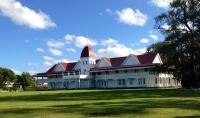 An early start. 6am wake-up call, and painful departure from my super comfortable and chic suite at the Westin. A quick ride to the Nadi airport and a short 20 minutes hop to Fiji's capital city Suva. The Suva international airport was about 20km east from the city. I checked my bag to Nuku'alofa and hired a taxi to take me to Suva for some sightseeing and then back to the airport. I had about 4 hours, which gave about 3 hours in the city.
An early start. 6am wake-up call, and painful departure from my super comfortable and chic suite at the Westin. A quick ride to the Nadi airport and a short 20 minutes hop to Fiji's capital city Suva. The Suva international airport was about 20km east from the city. I checked my bag to Nuku'alofa and hired a taxi to take me to Suva for some sightseeing and then back to the airport. I had about 4 hours, which gave about 3 hours in the city.
Suva was rather compact but it was hilly, so some comfy boots for hiking were a bonus. I went to see lovely parliament building, whose grounds were open to visitors. Suva was experiencing light showers, so I could not take too many photos. I was actually surprised how many large cruise ships would dock in Suva for the tourists to descend onto the city to have a look around and do some shopping. However, few of them was actually going to see the parliament and the Suva's monuments. They were mainly interested in shopping!
The flight from Suva to Tongatapu (Nuku'alofa) left 30 minutes early without a warning! Flights with Fiji's Air Pacific have a tendency of leaving 30 minutes early without any prior advise. And although the recommended three hours prior departure seems ludicrous, it is probably wise to show two hours before departure, as they'd close the check-in an hour before the plane leaves.
So, I landed early, in the late afternoon, could still have a look around Tonga's capital. It was lovely. Nuku'alofa was a very interesting little town boasting a good number of interesting buildings. Those included the Royal Palace, The Parliament, the Free Church of Tonga, a few examples of other sacral and colonial architecture.
|
Page:
 2 3 4 5 6 7 8 9 10 11 12
2 3 4 5 6 7 8 9 10 11 12

|
|
|
